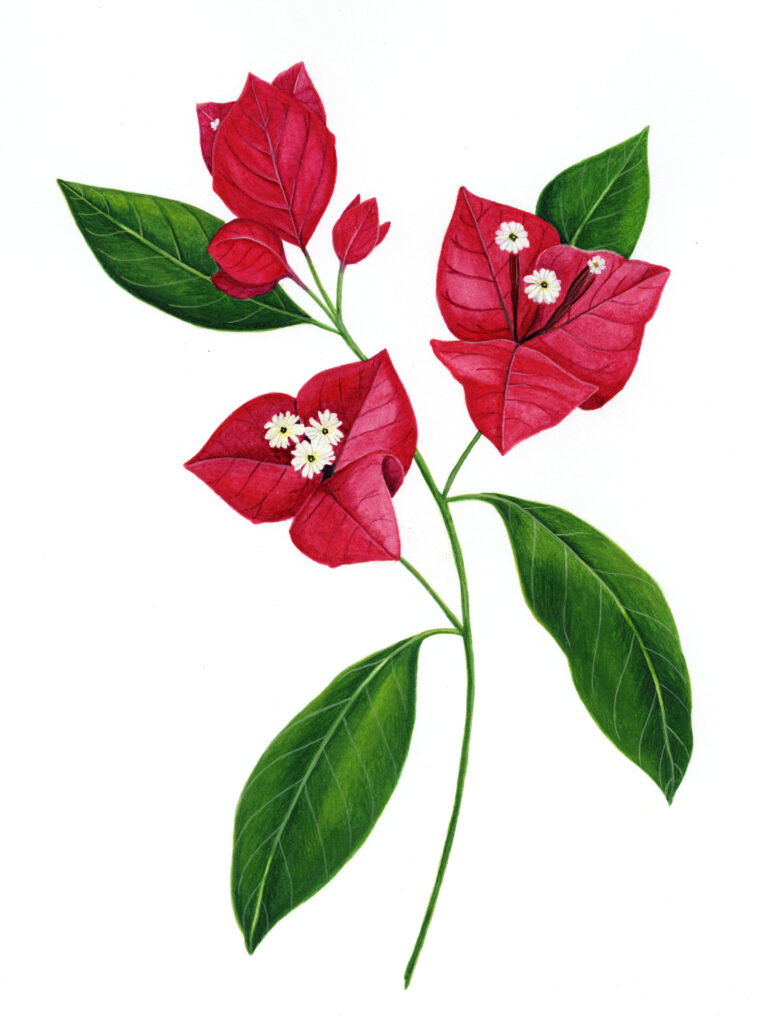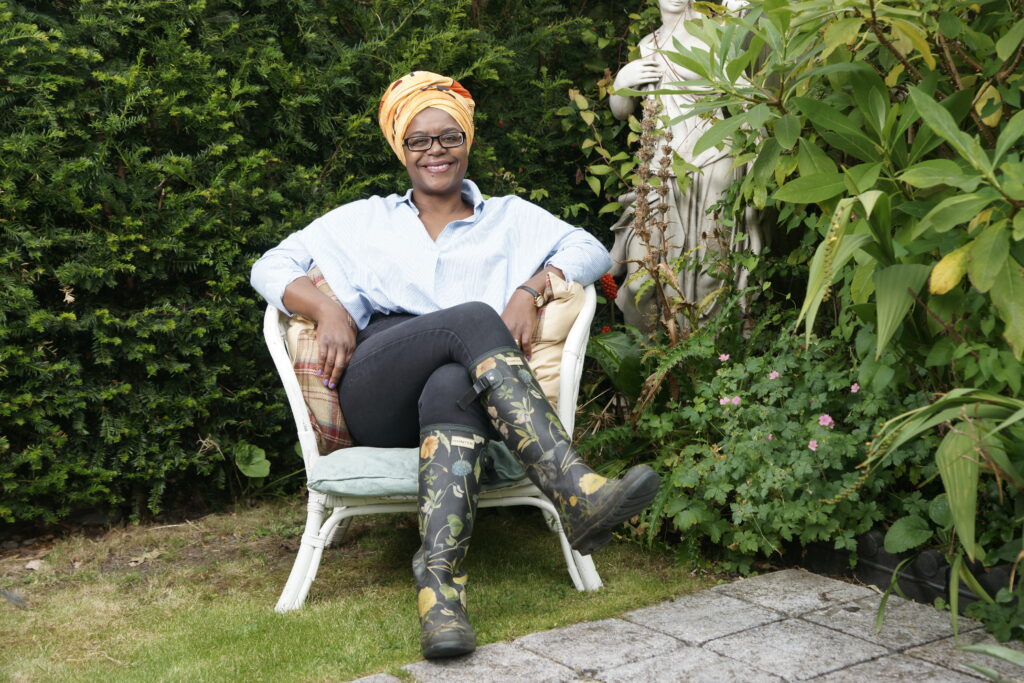Have you ever wondered where your favourite garden flowers came from? Where their names are derived from? Or why some cultivars go in and out of favour? Every flower we grow has a story, and in her new book A Short History of Flowers: The Stories That Shaped Our Gardens, garden historian and BBC Gardener’s World presenter Advolly Richmond takes you on a tour of the most intriguing, surprising and enriching.
Ahead of the launch at the museum next Tuesday 28 May, Advolly shares the surprising story behind the naming of the bougainvillea:
Bougainvillea
Bougainvillea spectabilis

Bougainvillea spectabilis has become synonymous with an unabashed flamboyancy: it demands your attention, unlike, perhaps, the person who originally brought it back to Europe. The plant’s beauty lies not in its tubular flowers, but in the blousy colours of the papery bracts that surround them.
The often-told story of how the bougainvillea got its name, which we’ll get onto shortly, goes hand in hand with the lesser-known tale of the first woman to circumnavigate the globe, said to be an herb woman with an extensive knowledge of plants and their medicinal properties.
The life of Jeanne Baret (1740–1807) is steeped in mystery. Certainly by the 1860s, she was living in Paris with the man who was to change her life immeasurably, the eccentric and self-absorbed French naturalist Philibert Commerçon (1727–73). In 1766, Commerçon joined the first French expedition to circumnavigate the globe as the ship’s doctor and naturalist under the command of the debonair Louis Antoine de Bougainville (1729–1811). During the proposed three-year expedition, Commerçon was to sail on the Etoile with Bougainville on its sister ship, the Boudeuse.

Not to be left behind and ignoring the prohibition of women aboard the King’s ships, Baret bound her breasts with strips of linen beneath loose-fitting men’s clothes and quietly slipped on board the Etoile just minutes before it sailed. Was Commerçon part of the charade? Certainly, he noted in his journal, ‘… they have given me a valet named “Jean” Baret!’
Sharing a spacious cabin with Commerçon afforded Baret a small degree of privacy away from the 117 crew. And it seems any initial suspicions of her gender were allayed by her claims of being a eunuch.
In June 1767, the Etoile joined the Boudeuse in Rio de Janeiro. It was during this stop that Baret and Commerçon collected a variety of plant specimens, including a rather eye-catching magenta-coloured scrambling climber. Commerçon described and labelled the specimen ‘Buginvillaea’. At each place the Etoile anchored, Baret and Commerçon searched for plants with potential commercial or medicinal value. Commerçon suffered frequent bouts of ill health, therefore it is entirely possible that Jeanne Baret, botanising on her own, collected many of the thousands of plant specimens obtained during the Bougainville expedition.

Suspicion reared its head now and then about her gender, the men noting how ‘Jean’ never grew any facial hair nor undressed or relieved himself in front of them. She even managed to navigate her way, probably with the aid of Commerçon, through the ‘baptism on the line’ ceremony for a sailor’s first crossing of the Equator, which involved being stripped and drenched with sea water.
There had been near misses, of course, but it was only in early 1768, almost eighteen months into the voyage, that Baret’s true identity was revealed.
Several people on the voyage kept journals, including Bougainville himself. This has led to contradictory versions of how and where Baret was finally discovered. Once exposed, Baret confessed to Bougainville that she had initially deceived Commerçon, thus avoiding implicating him.
In December, eight months after her exposure, the Etoile reached the Île de France (Mauritius). Commerçon became very ill and was unable to continue the journey. Baret remained with him at Port Louis as the Bougainville expedition headed home to France. Commerçon died in early 1773, leaving Baret almost destitute, except for around forty boxes of specimens. Baret reverted to dressing as a female and, in May 1774, married a French soldier, Jean Dubernat, ensuring her a safe passage back home. Just as she had quietly slipped on to the Etoile nine years earlier, so too did she unobtrusively walk down the gangplank onto French soil in 1775, to become the first woman to circumnavigate the globe.
Fourteen years after Baret’s return, the French botanist Antoine Laurent de Jussieu (1748–1836) described the genus ‘Buginvillaea’. A note in Commerçon’s handwriting read, ‘no plant with this character has been reported, we are allowed to give to the newly founded genus a new name and derive it from the most famous Mr de Bougainville, someone who appreciates all fields of natural history, the arts and sciences’. What is interesting is the use of ‘we’ in Commerçon’s labelling. By 1799, the name Bougainvillea spectabilis had been validly published by Professor Carl Ludwig Willdenow (1765–1812). Spectabilis comes from the Latin for ‘admirable’ or ‘remarkable’, words which could easily apply to Jeanne Baret.
Baret was awarded a state pension in recognition of her contributions during the Bougainville expedition. This generosity appears to have been endorsed by Bougainville himself, who, in 1785, wrote of Baret’s strength, courage and botanical expertise. Baret died twenty-two years later, on 5 August 1807, at the age of sixty-seven.
Over 250 years later, in 2012, Baret was finally commemorated in a new species of nightshade, Solanum baretiae, a trailing vine with a variety of leaf shapes and petals, in a range of colours, from white to violet, with hints of yellow. The plant’s contradictory features seem to echo the everchanging persona of Jeanne Baret.
—
Advolly Richmond will be joined in conversation by illustrator Sarah Jane Humphrey and horticultural journalist Naomi Slade on Tuesday 5 June to celebrate the launch of A Short History of Flowers:
Book tickets (available in person or online)

